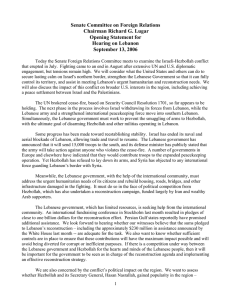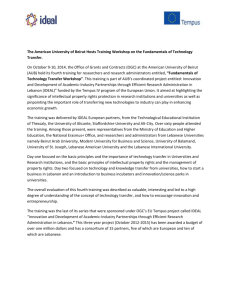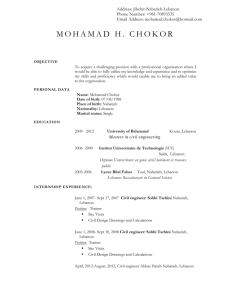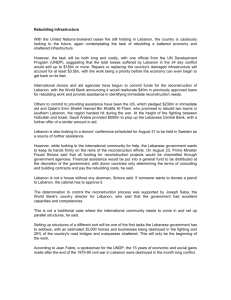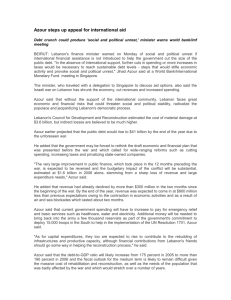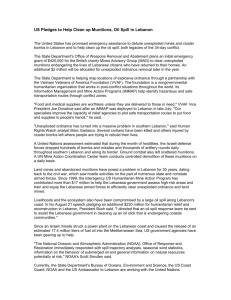Carlos Pascual Vice President, The Brookings Institution September 13, 2006
advertisement
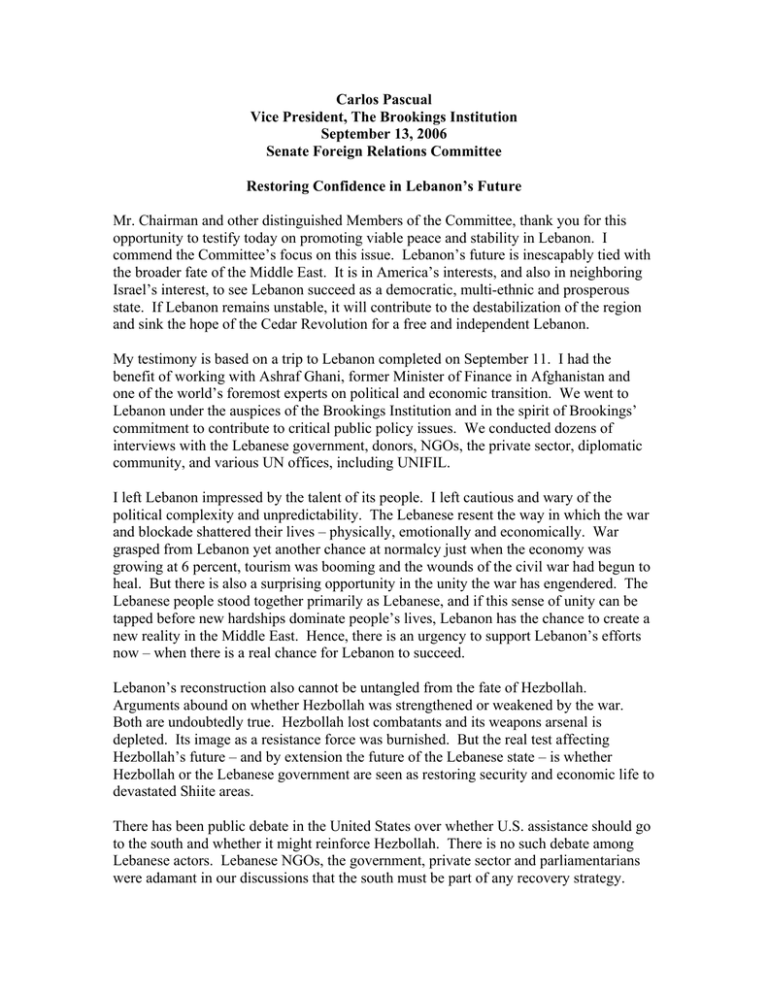
Carlos Pascual Vice President, The Brookings Institution September 13, 2006 Senate Foreign Relations Committee Restoring Confidence in Lebanon’s Future Mr. Chairman and other distinguished Members of the Committee, thank you for this opportunity to testify today on promoting viable peace and stability in Lebanon. I commend the Committee’s focus on this issue. Lebanon’s future is inescapably tied with the broader fate of the Middle East. It is in America’s interests, and also in neighboring Israel’s interest, to see Lebanon succeed as a democratic, multi-ethnic and prosperous state. If Lebanon remains unstable, it will contribute to the destabilization of the region and sink the hope of the Cedar Revolution for a free and independent Lebanon. My testimony is based on a trip to Lebanon completed on September 11. I had the benefit of working with Ashraf Ghani, former Minister of Finance in Afghanistan and one of the world’s foremost experts on political and economic transition. We went to Lebanon under the auspices of the Brookings Institution and in the spirit of Brookings’ commitment to contribute to critical public policy issues. We conducted dozens of interviews with the Lebanese government, donors, NGOs, the private sector, diplomatic community, and various UN offices, including UNIFIL. I left Lebanon impressed by the talent of its people. I left cautious and wary of the political complexity and unpredictability. The Lebanese resent the way in which the war and blockade shattered their lives – physically, emotionally and economically. War grasped from Lebanon yet another chance at normalcy just when the economy was growing at 6 percent, tourism was booming and the wounds of the civil war had begun to heal. But there is also a surprising opportunity in the unity the war has engendered. The Lebanese people stood together primarily as Lebanese, and if this sense of unity can be tapped before new hardships dominate people’s lives, Lebanon has the chance to create a new reality in the Middle East. Hence, there is an urgency to support Lebanon’s efforts now – when there is a real chance for Lebanon to succeed. Lebanon’s reconstruction also cannot be untangled from the fate of Hezbollah. Arguments abound on whether Hezbollah was strengthened or weakened by the war. Both are undoubtedly true. Hezbollah lost combatants and its weapons arsenal is depleted. Its image as a resistance force was burnished. But the real test affecting Hezbollah’s future – and by extension the future of the Lebanese state – is whether Hezbollah or the Lebanese government are seen as restoring security and economic life to devastated Shiite areas. There has been public debate in the United States over whether U.S. assistance should go to the south and whether it might reinforce Hezbollah. There is no such debate among Lebanese actors. Lebanese NGOs, the government, private sector and parliamentarians were adamant in our discussions that the south must be part of any recovery strategy. Some stressed that failure to reach the south after the last civil war gave no alternative to Hezbollah’s development as a state within a state. NGOs indicated that they have options to work with groups other than Hezbollah. Alternatively, ignoring the south would entrench a Shiite view that they have no place in Lebanon’s politics and increase the midterm prospects for political turmoil. The practical options are straightforward: mitigate the risk of benefiting Hezbollah by using international NGOs as a short-term means to control and disburse resources, or block such assistance and make clear that neither the Lebanese government nor the international community has an interest in Lebanon’s Shiites. The latter will simply institutionalize instability. Three Major Challenges To achieve and sustain its recovery, Lebanon must address three enormous challenges. The first is to mitigate the immediate impacts of war so that those returning to destroyed homes and livelihoods can begin to rebuild their lives. It is crucial to get as much done as possible by November, before winter begins. The principal needs are in the south and in Beirut’s southern suburbs. A rough estimate of the immediate cost is $600 million. The second challenge is to build critical social, economic and physical infrastructure. The focus should be on putting to work Lebanon’s strongest asset: the private sector. Needs assessments are still being completed, but we should expect a cost of around $3.5 billion. Thirdly, Lebanon must rectify structural economic and financial issues that have saddled the country with the world’s highest per capita debt. These core reforms are made harder by lost revenues and increased expenditures due to the war. A conservative base figure to make up for lost revenues this year is $1 billion. This total estimated cost – $5.1 billion to begin to address credibly all three sets of challenges – is illustrative and conservative. It does not compensate for $2.5 billion in capital flight or resources needed to stimulate large scale private investment. It does not provide for targeted subsides that will be needed to facilitate critical reforms, especially in the electricity sector, or for crucial refinancing of the public debt. It does not include the cost of strengthening the Lebanese military and equipping it to monitor its borders and prevent or disrupt arms flows. As detailed later, the U.S. should set a target of 15% of this total – $750 million – for recovery and reconstruction. This percentage would be comparable to American contributions to tsunami relief and reconstruction in 2005. To date, of the $230 million the U.S. has pledged, about $180 million would support this target (i.e., excluding security assistance). For context, this one-time injection of $750 million would be about one third of what the United States provides each year to Israel in Foreign Military Financing – and the goal, in effect, is the same. If Lebanon cannot function as a state, Israel will face yet a greater threat of instability and terrorism. We cannot overestimate the difficulty of addressing these challenges simultaneously, yet Lebanon has little choice if it is to move beyond crisis management to stable growth. Reconstruction investments can stimulate near-term gains, but they cannot be sustained without a viable economic base. The fact that there has not been an economic meltdown in spite of the war’s destruction, costs, lost economic opportunity, and both human and capital flight is a tribute to the management of the Lebanese authorities. They have 2 demonstrated that they have the talent to succeed. The Lebanese people and private sector have determination and resilience. But Lebanon needs a major injection of international resources to seize this opportunity to create a new reality of multi-ethnic success in the Middle East. Restoring Political Confidence I have been asked to focus on issues related to reconstruction, but I would be remiss not to underscore the linkages between economic progress and the need to help Lebanon build confidence in the state. The Lebanese state must be perceived as able to provide security and restart the economy in order to get all sectarian groups to buy into a unified Lebanon and transform Hezbollah’s existence as a state within a state. Perceptions of security and state competence are crucial to attracting international capital and the return of 500,000 Lebanese dual citizens who left during the war. The way in which reconstruction efforts are carried out – whether they help the state become an effective actor that also enables the private sector – will strongly shape perceptions of state competence. It will be just as important to take actions that give both international and internal actors confidence that political stability can hold and that war is not likely to commence yet again. To be sure, the ideal solution is a comprehensive peace agreement for the Middle East, but that will take time and a restoration of trust in the region. In the interim, several actions can make a symbolic and substantive impact and contribute the successful implementation of UN Security Council Resolution 1701: • • • • Trilateral coordination on military issues among Lebanon, Israel and UNIFIL are facilitating an orderly transition from Israeli to international and Lebanese forces in the south. This experience should be institutionalized, perhaps in a Joint Military Commission, to allow for more effective monitoring and communications. If crises arise, communications can occur through established and tested channels. Israel and Lebanon should explore the range of engagement they can undertake in the spirit of the 1949 Israel-Lebanon Armistice Agreement. That arrangement remains valid even if details are outdated. But its fundamental purpose, if pursued in spirit, is to underscore that neither side has the intent to attack each other. Such assurances are critical to positioning the Lebanese state to create conditions that can make obsolete Hezbollah’s rationale for its militia and facilitate consensus on its disarmament. The international community must act on its promise to equip the Lebanese military to control its border effectively, including with helicopters and unmanned aerial surveillance. While Syria appears to have accepted international technical assistance to Lebanese forces patrolling the Syria-Lebanon border, the Lebanese forces need the capacity to act to avoid Hezbollah’s rearmament with new and more sophisticated missiles. International support should be provided to help the Lebanese military coordinate with internal security forces and the police. If we failed miserably at such coordination to prevent 9/11, we certainly should not assume that Lebanon has the resources, equipment and capacity to do so. 3 • • Risk insurance and guarantees for private investment (through IFC, OPIC, EIB) will help shape perceptions that the international community has reached consensus to secure Lebanon’s future and is willing to back it financially. Finally, the international community in its diplomacy should assure the Lebanese government that it supports the need to integrate Shiites more fully into the governance of Lebanon. The means for this need to be internally defined, and it will take time to reach consensus. But all actors, internal and external, should back a dialogue that makes the Shiia community believe that its needs are best met by buying into the Lebanese state, not by supporting an organization that acts outside it. Near-term Humanitarian Aid and Economic Recovery The war displaced 1 million people, a quarter of Lebanon’s population, and it destroyed or partially destroyed 30,000 housing units. It destroyed crops and tourism in the south, taking away two main sources of income for the year. Losses were concentrated in the Shiite south and southern suburbs of Beirut. The immediate objective must be to facilitate viable returns for the displaced by November, before winter sets in. The key needs are shelter, water, electricity and the reopening of schools. Families will need transitional subsidies to compensate for lost income. Numerous needs assessments have been done, but neither the government, nor the UN, nor the NGO community seems to have a comprehensive picture on the near-term requirements. For planning purposes, we can estimate a family need of $20,000 for each of the 30,000 destroyed or partially destroyed homes, including investments that should benefit the community more broadly. That suggests a funding need on the order of $600 million. The Stockholm pledging conference raised $940 million, but it is a mixture of direct bilateral funding for NGOs and funds promised through a yet-to-be created early recovery trust fund. Without a clear picture on the mechanisms to access funds, the Lebanese government does not yet have the means to get them in a timely way to those who need them most. At a municipal level, government capacity is limited. Hezbollah is said to be under strain due to the magnitude of the reconstruction task and is increasingly leaving space for government and other NGOs. In some areas NGOs are reportedly bumping into each other; other areas are reportedly ignored. Given the time constraints, perfection is not possible, but a number of steps can be taken: • • Donors should work with the government and UNDP to get data immediately into a new database controlled by the Prime Minister’s office on early recovery and reconstruction support, broken down to the village level and generic types of assistance. This can provide a basis to identify gaps in needy areas and determine where funds are already programmed to reduce duplication. International NGOs working in partnership with local NGOs should be the immediate vehicle to disburse funds for recovery in the south. This is not ideal as it bypasses the government as a financial channel, but there are no alternatives in the short-term. 4 • • To bring government into the picture, the government and NGOs should create coordination mechanisms through Municipal Federations that bring together several municipalities. The focus should be to identify needs, adjust programming and give the government a management role in responding to local communities. This is the first step in bringing Shiia communities into more direct relationships with government structures. The Lebanese government needs to create a central point of contact in the national government to liaise with municipalities, and link municipal needs to international funding. Municipalities currently fall under the Ministry of Interior, whose primary task is internal security. A direct substantive link is needed to the Ministry of Finance. U.S. assistance is working through NGOs to get resources to communities. Many NGOs have worked bravely through the conflict and its aftermath. However, there is still no clear understanding among NGOs, the Lebanese government, and even many U.S. officials on how the $230 million U.S. pledge will translate into projects and where they will be focused. There is no clear strategy for any donor or the Lebanese government to make resources channeled through NGOs work to reinforce the Lebanese state. Given the crisis environment, that is not surprising. Now there is an urgent need to give greater coherence to these efforts. Building Social, Economic and Physical Infrastructure As Lebanon moves beyond immediate recovery, it must build a sociopolitical and economic foundation that strengthens the private sector, creates jobs and integrates Lebanon’s poorest communities with the rest of the country. Four sets of initiatives can help. The first is to give communities a practical role in setting priorities, acting on them and providing oversight. Indirectly, such an initiative can provide an immediate boost to employment. If these communities have a stake in decision making and can see a link between their involvement and community-based investments, they will have a greater stake in a unified Lebanon. Experience in Afghanistan has shown that such initiatives can work at community level even when resources are limited. In Lebanon, there are two added tools: a well developed banking sector and a vibrant civil society. Eventually the model would be for the Ministry of Finance to open project-specific bank accounts. Initiatives could start in the South. To tap into the accounts, each municipality would need to select an oversight committee that represents different segments of society. Communities would agree on specific projects. Pre-screened NGOs, university affiliates and private firms could be contracted to work with communities to develop and implement projects. Funds would become available once local oversight committees decide on a project, register it with a municipality, and select an implementation partner to provide support. Funds would be disbursed in tranches based on performance, with final payment coming with the completion of a project. In the initial stages, outside partners (NGOs, universities, private consultants) may need to take a direct role in 5 implementation, phasing down over time. The government would be seen as supporting but not directing community activity. Banks would provide a means to control, track and audit payments. There is no “correct” funding level for such a program, but $100 million could cover the south and northeast in its first 18-24 months. Second is a job creation program. There is no community in Lebanon that is not within 30 minutes of a bank. Commercial banks have experience in administering micro and small business finance. There is liquidity in the banking system, but risk is high, and thus interest rates and lending terms are prohibitive for small businesses. One part of the initiative would provide partial guarantees and subsidies to lower interest rates, provide a repayment grace period, and extend the term of lending. While such subsidies would need to be phased out, they would open the credit market to a wide range of small entrepreneurs whose businesses have been destroyed or disrupted by war. The second part of the initiative would rely on NGOs to survey communities and put in place contracts with universities and private firms to provide services and training to entrepreneurs. Depending on the actual risk assessments, $100 million in guarantees could generate several times that amount in actual lending. Another $50 million should be used to put in place training and technical support contracts. For illustrative purposes, if this initiative funded 10,000 loans at $20,000, with each loan supporting projects that generate on average 10 jobs, that would create 100,000 jobs. Assuming each job benefits a family of 5, one can affect about half of the south’s population. Third is the need for large-scale private sector financing that could invest in new business opportunities and support restructuring and modernization of medium and large scale enterprises. Lebanon had been regaining its place as a hub for business and financial services for the Gulf; its engineering and construction companies were rebuilding much of the Gulf. A major fund could help attract back $2.5 billion in capital flight and 500,000 skilled Lebanese who fled during the war. The Association of Islamic Banks has announced its intent to raise a $2 billion fund, with initial commitments of $200 million. Western investment agencies such as OPIC, IFC and EIB could contribute to the capitalization of such a fund through investments or insurance, potentially opening opportunities for American business through Lebanon into the Gulf. Fourth, infrastructure crucial to unifying the country, meeting social needs, and stimulating private activity needs to be rebuilt – or in some case built for the first time. Top priorities are electricity, water systems, roads and bridges. Needs assessments must still be completed, but preliminary estimates are on the order of $3.5 billion. The World Bank has completed a preliminary project design for electricity production, transmission and distribution. The Saudis and Kuwaitis have pledged between them $800 million for reconstruction. More will be needed, but the first step is to work out the modalities for project development and disbursement. Local firms can handle the design, supervision and construction. Ideally there would be one trust fund with common rules to manage reconstruction funds, yet many donors do not want to contribute to a single trust fund which they do not control. This issue must be addressed before the process of administering aid takes up more time than putting it to 6 work. The Lebanese Government has suggested the idea of countries “adopting” projects – which could work for roads and bridges. But clear standards and rules would need to be created to maintain quality and control corruption so that resources actually produce cost-effective results. The U.S. has agreed to adopt the Fidar Bridge, and we should contribute to this national reconstruction initiative, but we are unlikely to be a major financer of infrastructure. More important, the U.S. should consider a contribution of $100 million that could be managed by the World Bank for the Government of Lebanon to support feasibility studies that will accelerate the construction timetable. Internationally, it is not unusual for projects to be held up by more than a year for want of grant financing for feasibility work. In Lebanon, $100 million for feasibility studies could help leverage several billion dollars in project funding and give the U.S. a voice in the policy frameworks for such projects. It could also give the U.S. a role in the design and management of an international infrastructure fund where we might otherwise be excluded if we were not contributing directly to construction costs. Financial and Structural Foundations for Growth Lebanon’s Finance Minister and the Governor of the Central Bank deserve praise for keeping the currency stable and inflation in check despite massive capital flight and a sharp drop in revenues to the government. Saudi Arabia and Kuwait provided timely financial banking by transferring a total of $1.5 billion to bolster reserves. (Footnote: these funds cannot be used for reconstruction. They should not be counted toward international commitments for reconstruction.) But three pending problems must be addressed. The first is a need for $1 billion in budget support this year to compensate for revenue losses. The war caused a direct loss of about $650 million in revenues that could not be collected. It also caused the economy to contract from a projected 6% growth to at best no growth this year, causing another $350 million in revenue losses. The government budget will go from a projected primary surplus (before debt service) to a primary deficit. The government’s only alternative to finance this loss is by printing money, which would shatter its control over inflation. As discussed below, Lebanon has the highest per capita public debt in the world; taking on more debt to finance the deficit would only exacerbate a key structural problem. The second is a need to refinance the public debt of $36 billion. Private Lebanese banks hold $20 billion of this debt, and they have indicated that they will refinance. A key issue will be their willingness to allow a grace period at a minimal interest rate. The remaining $16 billion will require help from international official and private creditors. Working out a debt relief scheme will be complicated, but the U.S. could help catalyze the process, in conjunction with the EU, by asking the IMF to mount an urgent mission to develop possible financing alternatives. The United States and the EU should state their willingness in principle for OPIC and the EIB to contribute to a solution. 7 The third problem is rooted in the electricity sector. Subsidies to the sector cost the government about $1 billion annually. Between electricity subsidies and debt service, Lebanon spends half its annual revenues, crowding out other investments in infrastructure or the social sectors. Ending these subsidies will produce an economic shock and hardship among the poor, likely requiring a targeted subsidy program. This is exactly the type of initiative where donor grant funding for feasibility studies and technical assistance could have a massive multiplier effect. Status of International Assistance There is a great deal of confusion about how much has been pledged for Lebanon and how much is needed. Part of the problem is that pledges have not been comparable, and some humanitarian aid included in these totals may have saved lives – but it has been consumed and is not relevant to the future. A quick survey illustrates the confusion: • • • • • • Saudi Arabia ($800m), Kuwait ($300m) and Qatar ($300m) have pledged $1.4 billion in reconstruction assistance. Some may go through reconstruction funds, other parts may go to “adopt a village” programs. None of it has been spent. Saudi Arabia and Kuwait provided $1.5 billion to support reserves. This money cannot be spent and should not be counted as reconstruction assistance. The Stockholm early recovery conference raised $940 million. Some have said that a total of $1.2 billion has been raised when added with other pledges. But some pledges were for expended humanitarian aid. The pledges also mix humanitarian and early recovery projects. Of this amount, no government or donor entity in Lebanon could tell us the operative total for recovery and reconstruction. Private donors are raising funds, including investment funds such as the fund being developed by the Association of Islamic Banks. Such commercial funds will most likely invest in income-generating business and should not be counted upon to finance core reconstruction costs. The U.S. and others have pledged funds for security assistance; President Bush said it is $50 million of our $230 million pledge. At times security assistance gets mixed up with reconstruction pledges, adding more confusion about the totals. Some donors are counting assessed costs for UNIFIL peace-keeping mission to their contributions, and others are not. If we take as a base for recovery and reconstruction the $5.1 billion suggested above, the relevant pledges are likely on the order of $2.5 billion. Commercial funds are desperately needed to finance profit-making investment, but given Lebanon’s massive commercial financing potential the bulk of such commercial funds should not be counted against specific reconstruction targets. An exception should be made for small business finance. The costs for equipping the Lebanese military could run from $300 million to over $1 billion, depending on whether aerial surveillance and response capabilities are funded. Such funding needs should be tracked separately. The cost of peacekeeping should not be calculated in international totals since it is an assessed UN cost, but individual donors need to track their capacity to meet their assessed shares. 8 In short, there is still no danger of over funding. Recovery and reconstruction funding is probably half the needed total – in other words, a $2.5 billion gap. There is no clear picture on security assistance, but it is likely that on the order of another $500 million would be required if a robust border monitoring and response capacity is to be created. Adequacy of the U.S. Response For the most part, the U.S. portfolio addresses practical transitional requirements and uses responsible funding vehicles such as established NGOs to channel the funds. U.S. NGOs have played an important role in early recovery in Lebanon. The U.S. government works closely with the Siniora government in managing post-war crises. In nature and scope, the U.S. portfolio is what one would expect of a mid-sized country with good intentions and a limited strategic interest in Lebanon. If we subtract U.S. funding for security, our contribution is about $180 million, or about 3.5 percent of the total requirement. To be fair, $180 million should not be taken as the full U.S. contribution. There has been only a preliminary donors conference for early recovery and a major “reconstruction” conference is months off. But we need to be planning now for a major pledge that brings the U.S. total commitment, excluding security assistance, to $750 million – in other words, another $570 million above current commitments for recovery and reconstruction. In addition to this, the United State should provide yet more to support the Lebanese Army. The $50 million the U.S. has pledged is about six to ten times short of the lowerend requirement, and that does not even consider the need for support for Lebanon’s internal Security Forces. It would be premature to try to specify exactly how another $570 million should be used without in-depth analysis, but the analysis in this testimony is structured to provide a framework for programming. Broad program structures have been suggested, of which the U.S. can decide whether to fund a share. Illustratively, the outlines of such a program might be: • • • • • • • $100 million for community-based and municipal development. $150 million for job creation and small business finance. $100 million in OPIC and EXIM costs to generate on the scale of $300-500 million in private investment or finance. $70 million to contribute to small-scale targeted infrastructure projects. $100 million to support feasibility studies and related technical assistance for construction, infrastructure and structural reform (e.g., electricity sector) projects. $25 million to finance auditing, evaluation and accountability activities, including public-private partnerships on transparency. $25 million to build government and parliamentary capacity to monitor programs and communicate effectively with the public. 9 Actual allocations should be coordinated with the Government of Lebanon and other major donors. At least $300 million of the $750 million should start to be mobilized now, particularly for an expanded community development and job creation initiative, with the rest appropriated in FY 2007. With funding always tight in the Foreign Operations account, Israel might suggest to the U.S. Congress and Administration that about 10 percent of its $2.3 billion annual Foreign Military Financing allocation could be temporarily reallocated for reconstruction in Lebanon, as in the end it would contribute to a similar aim of Israel’s security and stability in the Middle East. Opportunity for Leadership and Change The reconstruction process in Lebanon will be complicated and at times controversial. Political pitfalls abound. This is a region with a history of corruption. Economic success is just as dependent on political developments and security as on sound policy and resources. In this environment, the U.S. has the opportunity to play a tangible leadership role that depends on a strong presence on the ground and regular diplomatic engagement. We have an opportunity make our presence felt more strongly: • • • • A stabilization and reconstruction specialist has just been deployed to Beirut. A team of 3-5 others should be added to the country team to coordinate the U.S. effort and create a strong on-the-ground capacity to provide leadership and coordinate with the government, UNIFIL and other donors. The U.S. can help the Lebanese leadership structure its own reconstruction team. UNDP is playing a particularly important role in coordinating resources, but much can be done informally to discuss management structures to interface with the international community and to handle aid flows. The U.S. can lend insights on creative public-private partnerships to monitor projects and combat corruption. We can lend informal support in conceptualizing public information campaigns so that the Lebanese understand the government’s strategy, see how funds are being used, and develop realistic expectations about assistance pledges. It is also important that we transform our own perception about what Lebanon’s reconstruction signifies. This is not merely a technical endeavor. Lebanon has the most ethnically diverse population in the Middle East. It has the strongest private services sector in the region. It has fundamentally democratic roots. Success in Lebanon has the potential to reverse a trend in the region toward extremism and intolerance. The Lebanese people have the talent to succeed. The international community can provide essential resources. The critical determinant will be the Lebanese state – whether it can engender the internal and international confidence to get all parties to support Lebanon politically and give it an enduring sense of stability. For all those who believe in peace in the Middle East, we have a stake in this endeavor. Thank you for your time. I would be pleased to address your questions. 10
